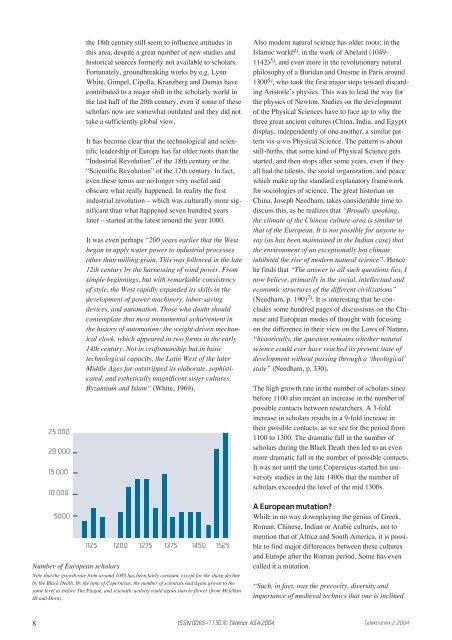Innovation Practice - Telenor
Innovation Practice - Telenor
Innovation Practice - Telenor
Create successful ePaper yourself
Turn your PDF publications into a flip-book with our unique Google optimized e-Paper software.
8<br />
25 000<br />
20 000<br />
15 000<br />
10 000<br />
5000<br />
Number of European scholars<br />
the 18th century still seem to influence attitudes in<br />
this area, despite a great number of new studies and<br />
historical sources formerly not available to scholars.<br />
Fortunately, groundbreaking works by e.g. Lynn<br />
White, Gimpel, Cipolla, Kranzberg and Dumas have<br />
contributed to a major shift in the scholarly world in<br />
the last half of the 20th century, even if some of these<br />
scholars now are somewhat outdated and they did not<br />
take a sufficiently global view.<br />
It has become clear that the technological and scientific<br />
leadership of Europe has far older roots than the<br />
“Industrial Revolution” of the 18th century or the<br />
“Scientific Revolution” of the 17th century. In fact,<br />
even these terms are no longer very useful and<br />
obscure what really happened. In reality the first<br />
industrial revolution – which was culturally more significant<br />
than what happened seven hundred years<br />
later – started at the latest around the year 1000.<br />
It was even perhaps “200 years earlier that the West<br />
began to apply water power to industrial processes<br />
other than milling grain. This was followed in the late<br />
12th century by the harnessing of wind power. From<br />
simple beginnings, but with remarkable consistency<br />
of style, the West rapidly expanded its skills in the<br />
development of power machinery, labor-saving<br />
devices, and automation. Those who doubt should<br />
contemplate that most monumental achievement in<br />
the history of automation: the weight-driven mechanical<br />
clock, which appeared in two forms in the early<br />
14th century. Not in craftsmanship but in basic<br />
technological capacity, the Latin West of the later<br />
Middle Ages far outstripped its elaborate, sophisticated,<br />
and esthetically magnificent sister cultures,<br />
Byzantium and Islam” (White, 1969).<br />
1125 1200 1275 1375 1450 1525<br />
Note that the growth rate from around 1050 has been fairly constant, except for the sharp decline<br />
by the Black Death. By the time of Copernicus, the number of scientists had again grown to the<br />
same level as before The Plague, and scientific activity could again start to flower (from Mclellan<br />
III and Dorn).<br />
ISSN 0085-7130 © <strong>Telenor</strong> ASA 2004<br />
Also modern natural science has older roots; in the<br />
Islamic world 4) , in the work of Abelard (1049–<br />
1142) 5) , and even more in the revolutionary natural<br />
philosophy of a Buridan and Oresme in Paris around<br />
1300 6) , who took the first major steps toward discarding<br />
Aristotle’s physics. This was to lead the way for<br />
the physics of Newton. Studies on the development<br />
of the Physical Sciences have to face up to why the<br />
three great ancient cultures (China, India, and Egypt)<br />
display, independently of one another, a similar pattern<br />
vis-a-vis Physical Science. The pattern is about<br />
still-births, that some kind of Physical Science gets<br />
started, and then stops after some years, even if they<br />
all had the talents, the social organization, and peace<br />
which make up the standard explanatory framework<br />
for sociologies of science. The great historian on<br />
China, Joseph Needham, takes considerable time to<br />
discuss this, as he realizes that “Broadly speaking,<br />
the climate of the Chinese culture-area is similar to<br />
that of the European. It is not possible for anyone to<br />
say (as has been maintained in the Indian case) that<br />
the environment of an exceptionally hot climate<br />
inhibited the rise of modern natural science”. Hence<br />
he finds that “The answer to all such questions lies, I<br />
now believe, primarily in the social, intellectual and<br />
economic structures of the different civilizations”<br />
(Needham, p. 190) 7) . It is interesting that he concludes<br />
some hundred pages of discussions on the Chinese<br />
and European modes of thought with focusing<br />
on the difference in their view on the Laws of Nature,<br />
“historically, the question remains whether natural<br />
science could ever have reached its present state of<br />
development without passing through a ‘theological’<br />
state” (Needham, p. 330).<br />
The high growth rate in the number of scholars since<br />
before 1100 also meant an increase in the number of<br />
possible contacts between researchers. A 3-fold<br />
increase in scholars results in a 9-fold increase in<br />
their possible contacts, as we see for the period from<br />
1100 to 1300. The dramatic fall in the number of<br />
scholars during the Black Death then led to an even<br />
more dramatic fall in the number of possible contacts.<br />
It was not until the time Copernicus started his university<br />
studies in the late 1400s that the number of<br />
scholars exceeded the level of the mid 1300s.<br />
A European mutation?<br />
While in no way downplaying the genius of Greek,<br />
Roman, Chinese, Indian or Arabic cultures, not to<br />
mention that of Africa and South America, it is possible<br />
to find major differences between these cultures<br />
and Europe after the Roman period. Some has even<br />
called it a mutation.<br />
“Such, in fact, was the precocity, diversity and<br />
importance of medieval technics that one is inclined<br />
Telektronikk 2.2004

















